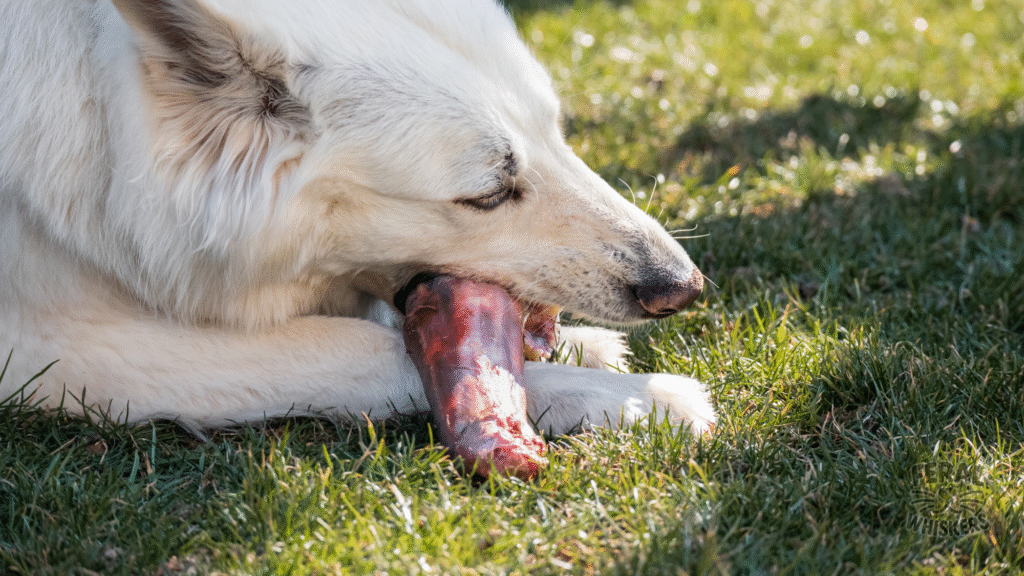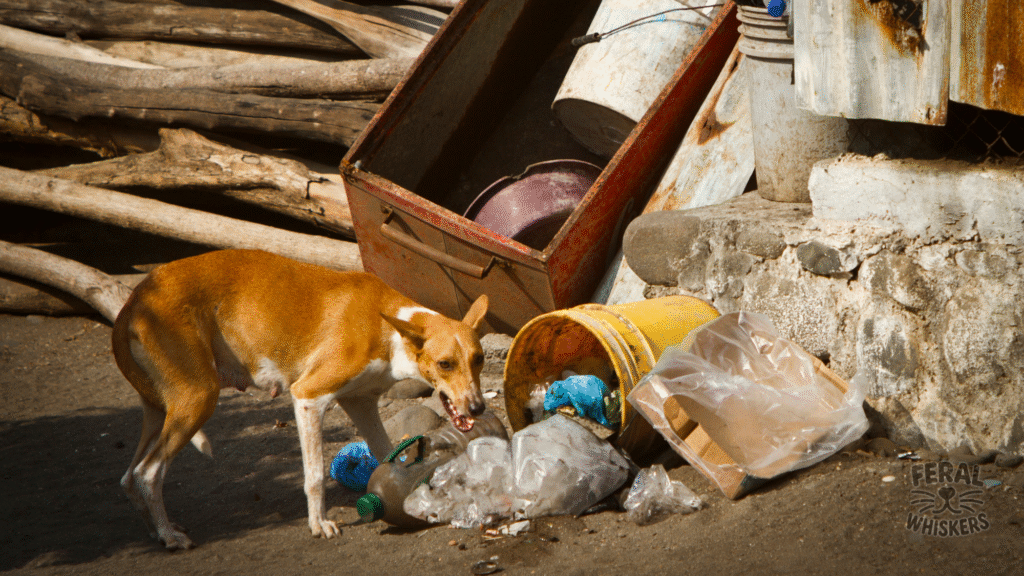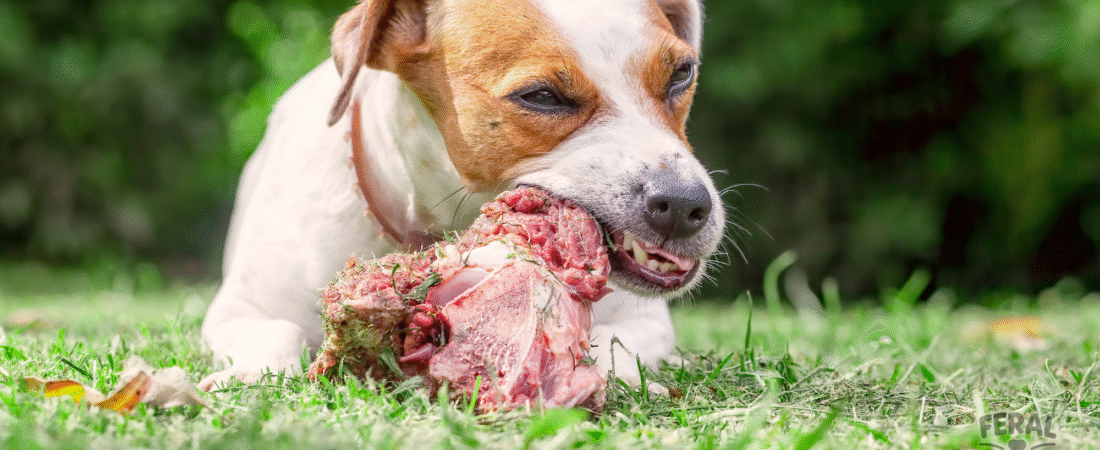Why Salmonella & Foodborne Infections Matter

Salmonella is a common type of bacteria that can cause gastrointestinal illness in dogs, humans, and many other animals. While dogs are generally more resistant to Salmonella than humans, they can still get sick, especially if their immune system is compromised, or if they consume a large dose of the bacteria.
Beyond Salmonella, other bacteria like E. coli, Clostridium, and Campylobacter can also cause foodborne illness in dogs. These infections are particularly relevant for:
- Dogs on raw diets: Raw meat, eggs, and unpasteurized dairy can carry these bacteria.
- Dogs that scavenge: Eating spoiled food, garbage, or feces.
- Puppies, seniors, and immune-compromised dogs: More vulnerable to severe illness.
👉 These infections are not just a risk to your dog; they are often zoonotic, meaning your dog can shed the bacteria and potentially infect humans in the household, especially children, the elderly, or those with weakened immune systems.
How Dogs Get Salmonella & Foodborne Infections

- Contaminated Raw Food: Raw meat, poultry, eggs, and unpasteurized dairy are common sources. Even commercially prepared raw pet foods can be contaminated.
- Scavenging: Eating garbage, spoiled food, dead animals, or feces from infected animals.
- Contaminated Water: Drinking from puddles, ponds, or other water sources contaminated with animal waste.
- Cross-Contamination: Bacteria from contaminated pet food (especially raw) can spread to human food preparation surfaces, bowls, or hands.
- Contact with Infected Animals: Direct contact with other dogs or animals shedding the bacteria.
Symptoms of Salmonella & Foodborne Infections in Dogs
Symptoms can range from mild to severe, depending on the dog’s immune system, age, and the amount of bacteria ingested.
Common Symptoms:
- Diarrhea: Often severe, watery, sometimes bloody, or containing mucus.
- Vomiting: Can be persistent, leading to dehydration.
- Fever: Elevated body temperature.
- Lethargy & Weakness: Dog appears tired, listless, and lacks energy.
- Loss of Appetite: Refusal to eat.
- Abdominal Pain: Dog may hunch, whine, or be sensitive to touch around the belly.
Severe Cases (More common in puppies, seniors, or immune-compromised dogs):
- Severe Dehydration: Sunken eyes, dry gums, skin tenting.
- Septicemia (Blood Poisoning): Bacteria enter the bloodstream, leading to systemic infection, shock, and collapse.
- Weight Loss: Due to chronic diarrhea and poor nutrient absorption.
- Neurological Signs: Tremors, seizures (rare, but possible in severe septicemia).
When to See a Vet 🩺
Seek immediate veterinary care if your dog exhibits:
- Severe, persistent vomiting or diarrhea (especially if bloody).
- Signs of dehydration.
- Extreme lethargy or collapse.
- High fever.
- Any of these symptoms in a puppy, senior, or immune-compromised dog.
Even if symptoms seem mild, a vet visit is recommended if you suspect Salmonella or other foodborne illness, especially if you have vulnerable individuals in your household due to the zoonotic risk.
Diagnosis
- Fecal Culture: The most common method. A stool sample is sent to a lab to grow and identify the bacteria.
- PCR Testing: Can detect bacterial DNA in fecal samples, offering faster results.
- Blood Tests: May show signs of infection (elevated white blood cells) or dehydration.
- Physical Exam: Vet assesses hydration, temperature, and abdominal pain.
Veterinary Treatment
Treatment focuses on eliminating the bacteria and providing supportive care.
- Antibiotics:
- Often prescribed for severe cases, puppies, seniors, or immune-compromised dogs.
- Important: Antibiotics can sometimes prolong shedding of Salmonella or lead to antibiotic resistance, so they are used judiciously.
- Fluid Therapy:
- IV fluids: For severe dehydration or if the dog cannot keep water down.
- Subcutaneous fluids: For moderate dehydration.
- Anti-diarrheal & Anti-emetic Medications: To control vomiting and diarrhea.
- Probiotics: To help restore healthy gut flora after antibiotic use.
- Nutritional Support: Bland, easily digestible diet (e.g., boiled chicken and rice) once vomiting subsides.
Holistic Support 🌿
Holistic approaches are crucial for supporting gut health, boosting immunity, and aiding recovery from the inflammation and dehydration caused by foodborne infections.
🥣 Healing Diet for Gut Recovery
The goal is to soothe the inflamed gut, provide easy-to-digest nutrients, and restore beneficial bacteria.
- Bland Diet:
- Boiled Chicken Breast (skinless, boneless): Excellent source of lean protein.
- White Rice: Easily digestible carbohydrate.
- Pumpkin (canned, plain): High in fiber, helps firm up stools.
- Bone Broth (unsalted, no onion/garlic): Hydrating, rich in amino acids for gut healing.
- Probiotic-Rich Foods:
- Plain, unsweetened Kefir or Yogurt: Introduce small amounts once vomiting stops to replenish good bacteria.
- Fermented Vegetables: Small amounts of sauerkraut juice (ensure no salt or spices) for beneficial enzymes.
👉 Gut-Healing Recovery Meal:
- 1 cup boiled white rice
- ½ cup shredded boiled chicken
- ¼ cup plain canned pumpkin
- 2 tbsp unsalted bone broth
Serve in small, frequent meals (3-4 times a day) to avoid overwhelming the digestive system. Gradually transition back to regular food over several days.
🌿 Herbal & Natural Remedies
These can help soothe the gut, reduce inflammation, and support the immune system.
- Slippery Elm Bark Powder: Mix with water to form a paste; coats and soothes the inflamed digestive tract.
- Marshmallow Root: Similar to slippery elm, provides a protective mucilage.
- Ginger: Small amounts of fresh ginger tea (cooled) can help settle nausea and vomiting.
- Activated Charcoal: Can be used in acute cases (under vet guidance) to absorb toxins, but must be given separately from other medications.
- Probiotic Supplements: High-quality, multi-strain probiotics are essential to re-establish healthy gut flora.
- Electrolyte Solutions: Offer diluted, unflavored electrolyte solutions (e.g., Pedialyte, or homemade with water, a pinch of salt, and a tiny bit of honey) to combat dehydration.
Prevention
Prevention is key, especially given the zoonotic risk.
- Safe Food Handling:
- Cook all meats thoroughly: If feeding cooked food, ensure it reaches safe internal temperatures.
- Avoid raw feeding (if concerned about risk): If you choose to feed raw, source from reputable suppliers, follow strict hygiene, and understand the risks.
- Wash hands: Thoroughly wash hands with soap and water after handling raw pet food, pet bowls, or cleaning up pet waste.
- Clean surfaces: Disinfect pet food bowls and food preparation surfaces regularly.
- Prevent Scavenging:
- Keep dogs away from garbage, dead animals, and feces.
- Supervise dogs in parks or outdoor areas to prevent them from eating unknown items.
- Water Safety:
- Provide fresh, clean drinking water.
- Prevent dogs from drinking from puddles, ponds, or stagnant water sources.
- Immune Support:
- Maintain a healthy, balanced diet to support a strong immune system.
- Consider daily probiotics for overall gut health.
Long-Term Outlook
- Mild cases: Most healthy adult dogs recover fully with no long-term complications.
- Severe cases: Puppies, seniors, and immune-compromised dogs are at higher risk for severe illness, septicemia, and even death. Survivors may have temporary digestive sensitivities.
- Chronic Carriers: Some dogs can become asymptomatic carriers, shedding Salmonella in their feces for weeks or months, posing an ongoing zoonotic risk.
Facts
- Zoonotic Threat: Salmonella is a significant zoonotic pathogen. Dogs can shed the bacteria in their feces, even if they appear healthy, and transmit it to humans.
- Raw Food Risk: Studies consistently show a higher prevalence of Salmonella and other pathogenic bacteria in raw pet foods compared to cooked or kibble diets.
- Immune Resistance: Dogs generally have a more acidic stomach and shorter digestive tract than humans, offering some natural resistance, but it’s not foolproof.
- Antibiotic Resistance: Overuse of antibiotics in Salmonella cases can lead to resistant strains, making future infections harder to treat.
- Environmental Persistence: Salmonella can survive in the environment (soil, water) for extended periods.
Common Questions
Can my dog get Salmonella from kibble?
Yes, though less common than raw food, kibble recalls due to Salmonella contamination do occur.
How long does Salmonella shed in dog feces?
Dogs can shed Salmonella for weeks to months after infection, even if they no longer show symptoms.
Is it safe to feed my dog a raw diet?
Raw feeding carries inherent risks of bacterial contamination. If you choose this diet, strict hygiene, reputable sourcing, and awareness of zoonotic risks are paramount.
What’s the difference between Salmonella and E. coli?
Both are bacteria that cause foodborne illness. Salmonella is a common cause of severe diarrhea, while certain strains of E. coli (like O157:H7) can cause severe, sometimes fatal, disease.
Final Takeaway
Salmonella and other foodborne infections are a serious concern for dogs, particularly puppies, seniors, and those with compromised immune systems. Beyond the risk to your pet, these infections pose a significant zoonotic threat to humans in the household.
- Prevention is paramount: Strict food hygiene, preventing scavenging, and providing clean water are essential.
- Treatment: Focuses on antibiotics for severe cases and supportive care (fluids, anti-diarrheals).
- Holistic support: A bland, gut-healing diet, probiotics, and soothing herbs are vital for recovery.
👉 Always prioritize food safety and hygiene to protect both your canine companion and your family from these potentially dangerous infections.

